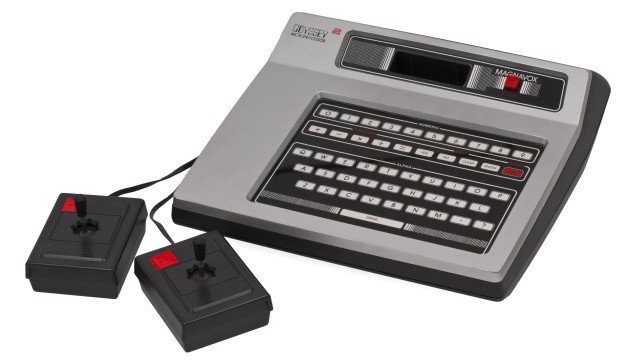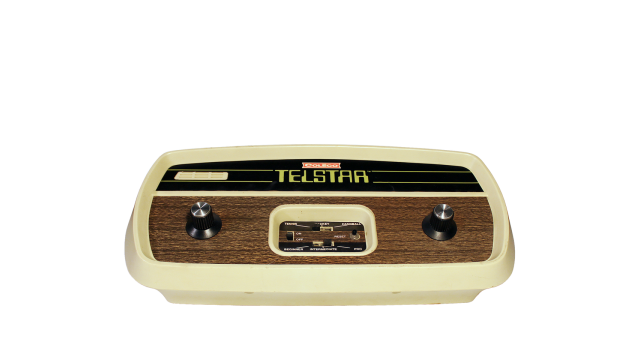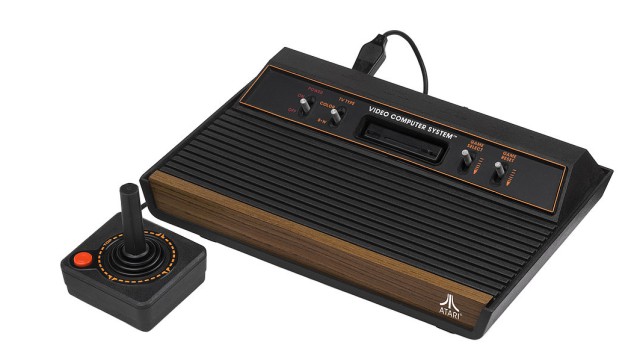
Magnavox Odyssey 2 / Philips Videopac G7000
Launches: 1978
Discontinued: 1984
Life span: 6 years
Units sold: 2 000 000
Generation: 2nd
Country releases of Magnavox Odyssey 2 / Philips Videopac G7000
 Europe: Europe: | Dec/1978 | ||
 USA: USA: | Feb/1979 | 179 | $ |
 Japan: Japan: | Sep/1982 | ||
 Brazil: Brazil: | May/1983 |
 Magnavox Odyssey 2 / Philips Videopac G7000 technical specifications
Magnavox Odyssey 2 / Philips Videopac G7000 technical specifications
CPU: Intel 8048
Memory: 64 B
 Magnavox Odyssey 2 / Philips Videopac G7000 video specifications
Magnavox Odyssey 2 / Philips Videopac G7000 video specifications
Magnavox Odyssey 2 / Philips Videopac G7000 graphics capabilities.
Video chip: Intel 8244 (NTSC) or 8245 (PAL)
Video connection: Radio Frequency
 Magnavox Odyssey 2 / Philips Videopac G7000 audio specifications
Magnavox Odyssey 2 / Philips Videopac G7000 audio specifications
Magnavox Odyssey 2 / Philips Videopac G7000 sound capabilities.
Audio chip: Intel 8244/8245
Audio mode: Mono
 Controllers of Magnavox Odyssey 2 / Philips Videopac G7000
Controllers of Magnavox Odyssey 2 / Philips Videopac G7000
 Magnavox Odyssey 2 / Philips Videopac G7000 games support
Magnavox Odyssey 2 / Philips Videopac G7000 games support
Support: Cartridge
Magnavox Odyssey 2 / Philips Videopac G7000 games
Games library:
Magnavox Odyssey 2 / Philips Videopac G7000 story
The Magnavox Odyssey 2, also known as the Philips Videopac G7000 outside North America, represents an important chapter in the history of home video game consoles, building on the legacy of the original Magnavox Odyssey. This successor aimed to capitalize on the growing popularity of video gaming in the late 1970s and early 1980s, introducing new technological features and a more sophisticated gaming experience. The story of the Odyssey 2's creation, development, launch, and market reception provides insights into the early days of video game innovation and competition.
The creation of the Magnavox Odyssey 2 began as a response to the rapidly evolving video game market. By the late 1970s, the original Odyssey had introduced the concept of home video gaming, but its technology was quickly becoming outdated in the face of more advanced systems like the Atari 2600. Recognizing the need for a more competitive product, Magnavox sought to develop a new console that could offer enhanced capabilities and appeal to a growing audience of gamers.
In 1978, Magnavox began working on what would become the Odyssey 2. The new console was designed to address the limitations of its predecessor, particularly in terms of graphics and sound. The Odyssey 2's development team, composed of engineers and designers at Magnavox, aimed to create a system that could deliver a richer gaming experience with more sophisticated visuals and audio. The project also sought to improve on the limitations of the original Odyssey, which relied heavily on physical accessories and lacked the versatility and appeal of newer gaming systems.
The development of the Odyssey 2 involved several key innovations. One of the most significant improvements was the introduction of a more advanced microprocessor. The Odyssey 2 was powered by the Intel 8048 microprocessor, which allowed for more complex and varied game programming compared to the original Odyssey. This microprocessor enabled the Odyssey 2 to display more detailed graphics and support more intricate game mechanics.
Another major advancement was the inclusion of built-in sound capabilities. Unlike its predecessor, which had very basic sound effects, the Odyssey 2 featured a sound chip that could produce a range of audio effects and simple melodies, enhancing the overall gaming experience. This was a significant improvement, as sound became an increasingly important aspect of video games.
The Odyssey 2 also introduced a new controller design. The console came with a pair of joysticks that featured a numeric keypad, which allowed for more complex input and gameplay. This design was intended to provide players with a greater level of control and flexibility compared to the simple dials of the original Odyssey controllers. The inclusion of the numeric keypad also allowed for more diverse game mechanics, as it could be used for a variety of in-game functions.
In addition to hardware improvements, the Odyssey 2's development also focused on expanding its software library. Magnavox aimed to create a strong lineup of games that would showcase the console's capabilities and appeal to a wide audience. The company worked with various game developers to produce a range of titles, including arcade-style games, puzzle games, and educational software. The goal was to offer something for every type of player, from casual gamers to more dedicated enthusiasts.
The launch of the Magnavox Odyssey 2 occurred in 1978, just six years after the original Odyssey's debut. The new console was marketed as a more advanced and versatile gaming system, with a focus on its improved graphics, sound, and control options. The Odyssey 2 was priced competitively, and Magnavox worked to build excitement around the new system through a series of promotional efforts. These included television advertisements, in-store demonstrations, and marketing campaigns that highlighted the console's technical advancements and diverse game library.
Despite these efforts, the market reception of the Odyssey 2 was mixed. The console was well-received by some consumers and critics, who appreciated the improvements in graphics and sound, as well as the more sophisticated controller design. The Odyssey 2's ability to display more detailed visuals and produce better audio effects was seen as a significant step forward from the original Odyssey, and the numeric keypad on the controllers was praised for adding depth to the gameplay.
However, the Odyssey 2 faced several challenges in the marketplace. One major issue was the increasing competition from other gaming systems. By the late 1970s and early 1980s, the video game market was becoming crowded with new and more advanced consoles. Systems like the Atari 2600 and the ColecoVision were gaining popularity, and their advanced graphics and sound capabilities made it difficult for the Odyssey 2 to stand out.
Another challenge was the Odyssey 2's relatively limited library of games. While Magnavox worked to create a diverse range of titles, the console's software lineup did not achieve the same level of recognition or popularity as some of its competitors. This was partly due to the rapid pace of innovation in the video game industry, which saw new and more advanced consoles being released at a fast pace.
Despite these challenges, the Odyssey 2 managed to achieve a degree of success. It sold well in several markets, particularly in Europe, where it was released as the Philips Odyssey 2. The console's ability to offer a more advanced gaming experience compared to the original Odyssey helped it carve out a niche in the competitive video game market. The Odyssey 2 also became known for its educational games, which were designed to appeal to parents looking for wholesome and enriching entertainment options for their children.
In the years following its launch, the Odyssey 2 continued to be supported with new games and accessories, although it never reached the same level of market dominance as some of its competitors. The console's legacy lies in its role as a bridge between the early days of home video gaming and the more advanced systems that would follow. It represents an important step in the evolution of video game technology, with its innovations in graphics, sound, and control paving the way for future developments in the industry.
Overall, the Magnavox Odyssey 2 is remembered as a significant early home video game console that introduced several key innovations and contributed to the growth of the video game industry. Its development and launch marked an important phase in the history of gaming, as it showcased the potential of home consoles to deliver more sophisticated and engaging entertainment experiences. While it faced challenges and competition in a rapidly evolving market, the Odyssey 2's contributions to the development of video game technology and its impact on the industry are still recognized and appreciated by gaming enthusiasts and historians today.
Previous Magnavox console: Magnavox Odyssey



